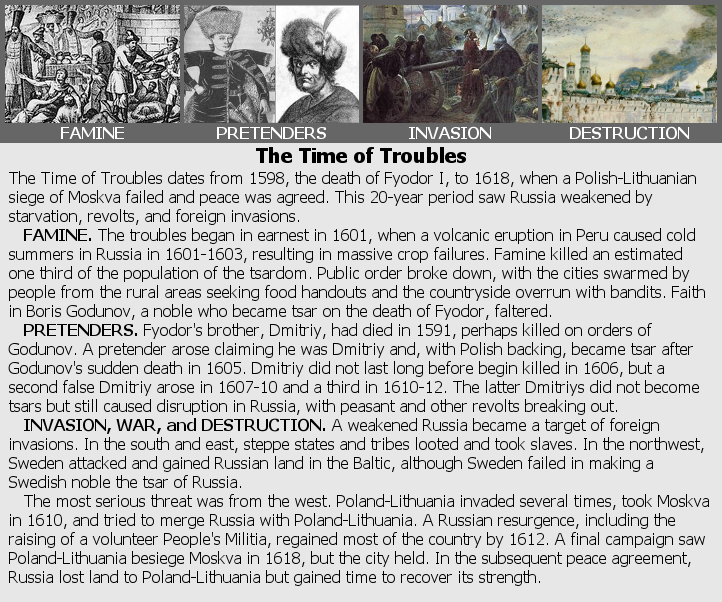

The Time of Troubles
The Time of Troubles dates from 1598, the death of Fyodor I, to 1618, when a Polish-Lithuanian siege of Moskva failed and peace was agreed. This 20-year period saw Russia weakened by starvation, revolts, and foreign invasions.
FAMINE. The troubles began in earnest in 1601, when a volcanic eruption in Peru caused cold summers in Russia in 1601-1603, resulting in massive crop failures. Famine killed an estimated one third of the population of the tsardom. Public order broke down, with the cities swarmed by people from the rural areas seeking food handouts and the countryside overrun with bandits. Faith in Boris Godunov, a noble who became tsar on the death of Fyodor, faltered.
PRETENDERS. Fyodor's brother, Dmitriy, had died in 1591, perhaps killed on orders of Godunov. A pretender arose claiming he was Dmitriy and, with Polish backing, became tsar after Godunov's sudden death in 1605. Dmitriy did not last long before begin killed in 1606, but a second false Dmitriy arose in 1607-10 and a third in 1610-12. The latter Dmitriys did not become tsars but still caused disruption in Russia, with peasant and other revolts breaking out.
INVASION, WAR, and DESTRUCTION. A weakened Russia became a target of foreign invasions. In the south and east, steppe states and tribes looted and took slaves. In the northwest, Sweden attacked and gained Russian land in the Baltic, although Sweden failed in making a Swedish noble the tsar of Russia.
The most serious threat was from the west. Poland-Lithuania invaded several times, took Moskva in 1610, and tried to merge Russia with Poland-Lithuania. A Russian resurgence, including the raising of a volunteer People's Militia, regained most of the country by 1612. A final campaign saw Poland-Lithuania besiege Moskva in 1618, but the city held. In the subsequent peace agreement, Russia lost land to Poland-Lithuania but gained time to recover its strength.
Comments
You may not have heard of the Russian Famine of 1601-1603 or the volcanic eruption in Peru that almost certainly caused the famine. In 1600, an eruption of the Huaynaputina volcano in Peru ejected massive amounts of ash and sulfuric dioxide into the atmosphere, affecting the climate of almost the entire Earth for several years. It caused lower-than-normal temperatures in Northern Hemisphere, and this hemisphere's summer of 1601 was one of the coldest in the last 600 years, followed by an extremely cold winter. Tree-ring evidence indicates at least some places were still colder than normal in 1603. Many places in the hemisphere were affected, with reduced harvests, crop failures, or famines recorded in what are now China, Denmark, Estonia, Finland, Japan, Norway, Russia, Sweden, and Turkey. The eruption likely disrupted normal weather patterns, as some areas in 1601 experienced droughts while others had excessive rain. In Russia, in addition to cold, extensive flooding from rain also disrupted agriculture, likely making crop failures and famine worse.
This disaster was the onset of Russia's Time of Troubles. Famine in 1601-1603 killed perhaps a third Russia's population through starvation and diseases caused by inadequate nutrition. Civil order broken down; tsars came and went, sometimes violently; riots and revolts became common. Russia even faced an existential crisis as both the Commonwealth of Poland-Lithuania and the Kingdom of Sweden, two great powers of the period, attacked and seized Russian territory. Each country even hoped to take over all of Russia. Poland-Lithuania at one point controlled most of western Russia and occupied Moskva before being repulsed.
By proportion, the human and economic losses of the Times of Troubles must have exceeded those of three other great disasters for Russia: the 13th Century Mongol invasion and conquest, the 1914-1922 World War I/Russian Civil War, and 1941-1945 Axis invasion of World War II. While famine and disease "only" killed about 2 million people in Russia in 1601-1603, this was about a third of the population. Russian deaths caused by WW2 were at least 22 million and perhaps as high as 30 million (the exact figures are still a matter of debate), representing about 11%-15% of the USSR's 1941 estimated population. It is thus no surprise that the desire to avoid another Time of Troubles motivated (and still motivates) many Russians. Unfortunately, ruthless autocrats and power-seekers in Russia have subverted (and still do subvert) this desire for their own ends rather than for the good of the country.